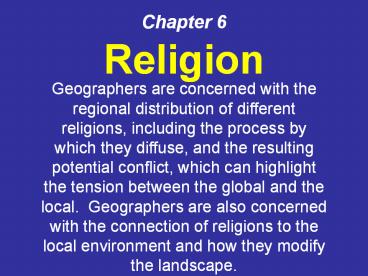Religion - PowerPoint PPT Presentation
1 / 10
Title:
Religion
Description:
Chapter 6 Religion Geographers are concerned with the regional distribution of different religions, including the process by which they diffuse, and the resulting ... – PowerPoint PPT presentation
Number of Views:223
Avg rating:3.0/5.0
Title: Religion
1
Chapter 6
- Religion
Geographers are concerned with the regional
distribution of different religions, including
the process by which they diffuse, and the
resulting potential conflict, which can highlight
the tension between the global and the local.
Geographers are also concerned with the
connection of religions to the local environment
and how they modify the landscape.
2
Key Definitions
- Monotheism-belief in a single God the belief
that there is only one God, as found in Judaism,
Christianity, and Islam - Polytheism- belief in several deities the
worship of or belief in more than one god,
especially several deities, as found Hinduism
3
Key Definitions
- Universalizing Religion- A religion that attempts
to appeal to all people, not just those living in
a particular location or of a particular
ethnicity - Ex. Christianity, Islam, and Buddhism
- Ethnic Religion- A religion with a relatively
concentrated spatial distribution and a strong
connection to the local environment - Ex. Hinduism, Confucianism, Daoism, Shintoism,
Judaism, Animism
4
Diffusion
- Some religions, like universal religions, are
designed to encourage the diffusion of the
religion. - Ethnic religions are usually tied to specific
place. - Migration usually accounts for the diffusion of
religions. - Unlike languages, however, people dont change
their religion when they move.
5
Distribution of Religions
- Where are these Universalizing religions
predominant today? - Christianity
- Where are the various branches of Christianity
predominant? - Islam
- Where are the branches of Islam predominant?
- Buddhism
- Where are the branches of Islam predominant?
- Baha I
- Sikhism
6
World Distribution of Religions
Global distribution patterns generally reflect
the universal or ethnic nature of the religion
and migration patterns.
7
World Population by Religion
About 60 percent of the worlds population
adhere to a universalizing religion, 25 percent
to an ethnic religion, and 15 percent to no
religion. Over two-thirds of the worlds
population belong to Christianity, Islam,
Hinduism, or Buddhism. Christianity is the single
largest world religion.
8
Diffusion of Universalizing Religions
Fig. 6-4 Each of the three main universalizing
religions diffused widely from its hearth.
9
Diffusion of Christianity
Fig. 6-5 Christianity diffused from Palestine
through the Roman Empire and continued diffusing
through Europe after the fall of Rome. It was
later replaced by Islam in much of the Mideast
and North Africa.
10
Key Definitions
- Branch- A large and fundamental division within a
religion - Ex. Catholicism (50), Protestantism (25),
Eastern Orthodox (10) - Denomination- A division of a branch that unites
a number of local congregations in a single legal
and administrative body - Ex. Baptist, Methodist, Pentecostal, Lutheran,
Presbyterian, Episcopal - Sect- A relatively small group that has broken
away from an established denomination - Ex. Coptic Church of Egypt, Ethiopian Church,
Armenian Church, Maronites, Mormons































